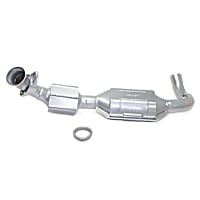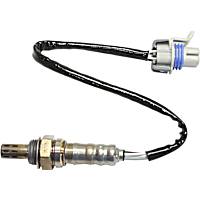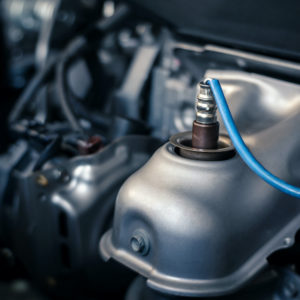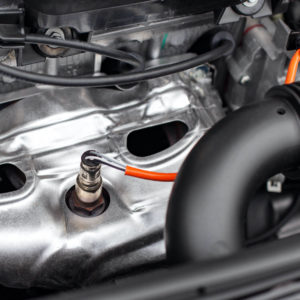There are around 11,000 different trouble codes in the OBD-II index, code P0141 being just one of them. This article will cover the details, causes, and symptoms of code P0141, so you could understand the issue better and come up with the proper fix.
What Does the Code P0141 Mean?
DTC P0141 stands for “Oxygen Sensor Heater Circuit Malfunction (Bank 1, Sensor 2).” It indicates that there’s a problem with the heater circuit of engine bank 1’s downstream O2 sensor. Your car’s PCM tests the oxygen sensors’ heater circuits for integrity. If it finds an issue in the heater circuit for the engine bank 1’s downstream oxygen sensor, it sets code P0141.
P0141 is part of a family of codes listed as follows:
- P0141 – Sensor Heater Circuit Bank 1 Sensor 2
- P0161 – Sensor Heater Circuit Bank 2 Sensor 2
- P0135 – O2 Sensor Heater Circuit Bank 1 Sensor 1
- P0155 – O2 Heater Circuit Bank 2, Sensor 1

Bank 1 vs Bank 2
With that in mind, it’s important to note that Bank 1 is always where the number 1 cylinder is located. Thus, on Ford pickups, Bank 1 is the passenger side bank, but on Chevy and Dodge pickups, Bank 1 is the driver side bank. You need to know this, or you may end up working on the wrong sensor, so make sure you know bank 1 from bank 2 before you start clearing any of these codes.
Bank 1 Sensor 2 is the oxygen (O2) sensor that’s in the middle of the catalytic converter or right behind the front catalytic converter (the converter that’s closest to the engine). Bank 1 Sensor 1 is the sensor between the engine and the catalytic converter. So make sure you know exactly which sensor is which before you start addressing the issue. Bank 2 has a sensor 1 and sensor 2 laid out the same way.
Oxygen sensors keep track of the oxygen levels in the air that’s entering and leaving the catalytic converter. These sensors send that data back to the car’s computer or PCM.

The PCM uses data from the upstream O2 sensor (the one before the converter) to fine-tune the engine’s air-fuel mixture. Meanwhile, the PCM uses data from the downstream O2 sensor (the one after the converter) to determine converter efficiency.
The PCM regularly tests the heater circuits for integrity. When it detects a problem in the heater circuit for the engine bank 1’s downstream oxygen sensor, it switches on the check engine light and logs the P0141 code.

Why Do Oxygen Sensors Need Heat?
It’s all about emissions. Oxygen sensors need to work as soon as possible (within a minute), but they won’t function below a certain temperature. Conventional O2 sensors need to reach 600°F. Meanwhile, O2 sensors that only have one wire won’t work until the exhaust raises its zirconia element to its operating temperature.
Oxygen sensors need to work as soon as possible (within a minute), but they won’t function below a certain temperature. Conventional O2 sensors need to reach 600°F.
– Richard McCuistian, ASE Certified Master Automobile Technician
Heated O2 sensors have four wires. Two of those wires are always the same color, usually either white or brown. Those are the two heater wires; one receives voltage with the key on (through a relay), and the other is the ground control from the powertrain control module (PCM).

In the center of the O2 sensor is a heating element that looks similar to a diesel engine glow plug element. You can’t see it without cutting the O2 sensor apart. It generally has around 6 ohms of resistance when cold, but a lot more resistance when hot.
The PCM measures and controls current flow to the heater element through the ground it provides to the element. The current flow is measured, so if there is no current flow, the PCM will flag that condition by setting a P0141 diagnostic trouble code (DTC).

What are the Possible Causes of the P0141 Code?
Several issues can lead to the PCM issuing an OBD code P0141. They include:
- Faulty oxygen sensor heater (most common)
- Circuit problems (e.g., damaged wiring, loose connections – fairly common)
- Issues with the PCM (e.g., software in need of an update – very rare)

What are the Common Symptoms of the P0141 Code?
There are only two common symptoms associated with code P0141:
If the OBD-II scanner indicates a P0141 trouble code, bring your vehicle to the nearest auto repair shop. A technician can determine if the fault lies with the oxygen sensor or somewhere else.
How to Diagnose the P0141 Code
It can be difficult to diagnose most OBD-II codes. In the case of code P0141, there is a wide spectrum of issues to choose from when trying to determine what’s causing the problem. As such, there isn’t one specific way to diagnose the trouble code.
To give you an idea of how to troubleshoot a P0141, check out the videos below:
How to Fix the P0141 Code
There isn’t a “magic bullet” fix for code P0141. As previously mentioned, there are many possible causes, which means there are different ways to fix the issue.
To properly fix the P0141 trouble code, you’ll need to perform an accurate diagnosis first. Once you know what’s causing the problem, only then can you conduct the necessary repairs.
And remember, all vehicles are different. When troubleshooting and repairing DTCs, don’t forget to consult the factory repair information for your application.
Repair manuals, such as those from Chilton, are useful, but an ALLDATA subscription is even better. ALLDATA has single-vehicle subscriptions for DIYers that provide detailed factory repair information.
Get a High-Quality Oxygen Sensor Replacement
Did your scan tool read a P0141 code? If it’s because of a bad oxygen sensor, you’ll need to replace the faulty to resolve the error code. Luckily, you don’t have to leave your home to buy an excellent oxygen sensor replacement for your ride when you shop online here at CarParts.com.
It only takes a few minutes to find and order what you need here at CarParts.com. Simply input your ride’s year, make, and model into our vehicle selector, and we’ll filter our catalog to show oxygen sensors that fit your ride. All our replacement parts are sold at competitive prices, so you’re sure to find one that fits your budget.
Need to get back on the road as soon as possible? Our warehouses are strategically located across the country, so expect your order to reach you in just a few days. If you’ve got questions, don’t think twice about contacting our 24/7 customer service team for help.
Don’t let a bad oxygen sensor ruin your trip. Take a look at our oxygens sensors and order yours today!
Products Mentioned in this Guide
Any information provided on this Website is for informational purposes only and is not intended to replace consultation with a professional mechanic. The accuracy and timeliness of the information may change from the time of publication.



 Catalytic Converter
Catalytic Converter
 Oxygen Sensor
Oxygen Sensor

















i have a 98 mazda b4000, replaced spark plugs and it started making a popping sound from the exhaust, keeps popping up a p0141 code but o2 sensors fine. checked maf, plugs, distributor, for vacuum leaks. could i be possible that since the cats are off its tricking the pcm into thinking the o2 is bad or that its running rich/lean?